The History of Gold’s Gym
In 1965, former bodybuilder and US Marine Joe Gold opened up a gym in Venice, California, as a place for himself and his friends to train. Charging $60 a year, Joe kept costs down by making his own gym equipment, skimping on the heating, and recruiting every bodybuilder worth his salt as a member.
Unbeknownst to Joe, his simple gym would eventually become an institution in the fitness world.
Why open a gym?
Since the early 1950s, we have seen muscle men flock to California to join the growing bodybuilding community at Venice Beach (1). Back then, the Santa Monica Pier was the go-to gym for aspiring muscle men.
Crudely decked out on a wooden platform, lifters competed over free weights, rings, dips, and chin-up bars. It wasn’t unknown for legends such as Steve Reeves to train in Santa Monica. In 1959, however, things changed.
Following allegations of sexual misconduct by a small cohort of bodybuilders, a decision was taken by the Santa Monica City Council to pull weights from the beach. Bodybuilders were seen as an anti-social group, and the decision to force them from the beaches and into small indoor gyms hardly helped matters.
Bodybuilders begrudgingly made their way into nearby gyms like the Dungeon, Wilshire, or Muscle Beach Gym. There was one bodybuilder who wasn’t content with the selection of gyms on offer.
In 1965, Joe Gold decided to open his own training facility for himself and his former Santa Monica compatriots. A man well versed in the comings and goings of the real estate market, Gold had by then amassed a tidy number of beachfront properties for a small sum. Joe soon decided that one of his properties on Pacific Avenue would serve as his new gym.
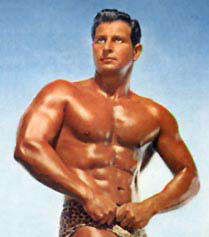 Joe Gold in his prime
Joe Gold in his prime
Gold had chosen his location well. Santa Monica’s lifters were Joe’s first pool of members, and when rumors began to emerge around Venice that Gold was opening up a serious training gym, lifters could hardly contain their excitement. Dick Tyler’s writing in August 1965 is one such example.
Here’s big news to all the BIG men reading this column. Well-known California muscle man, Joe Gold will soon be opening a gym at 1006 Pacific Ave. in Venice. For those of you who now know, Venice is just a stone’s throw from famed Muscle Beach. Joe, who owns some real estate hereabouts, is building the gym from the ground up. Nothing “made over” for Joe. Now this is going to be a gym for men. No fancy rugs or chrome – just plain old-fashioned weights and the greatest apparatus you ever saw.
How’s this for dumbbells? The gym will have two complete sets of dumbbells going from 10 lbs. to 80lbs. in five pound jumps. From there they’ll go to 150 lbs. by tens. Already Joe is having equipment made to order for the specialists. Joe is a Weider man and you can bet your bottom dollar that this is going to be a hot bed of training for Southern California strong men. Co-managing will be ole Zabo Koszewski himself. How can they miss? Those of you not already here in “Sunsville” better make Gold’s gym a tourist attraction.
Tyler’s predictions that the gym would be a hotbed of training proved to be true. Within five years, Gold’s boasted a veritable who’s who of the bodybuilding scene, with legends like Zane, Arnold, and Franco all regular attendees (2) but as the gym became increasingly popular, its owner became increasingly disgruntled. The gym was a money pit.
In 1970, Joe Gold sold the gym for $50,000 and became a merchant marine.
Contents
The Birth of Mecca
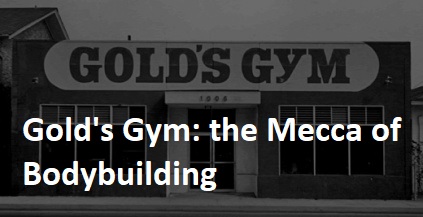
With Joe Gold now out, Gold’s Gym fell into the hands of Dave Saxe and Bud Danitz, who ran the gym for a little over two years before selling it on to Ken Sprague. Sprague had been training at Golds since 1969, and as owner, he would oversee its first expansion.
Almost immediately after buying the gym, Sprague began sponsoring bodybuilding contests, which regularly drew upwards of 5,000 fans. Sensing the need to attract greater and greater audience numbers, Sprague would create circus spectacles where half-clad bodybuilders would ride atop bull elephants to the music of brass bands. Amidst all this chaos, the Gold’s Gym logo would be brandished.
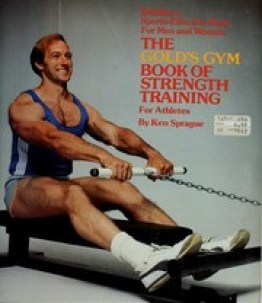 Sprague would put Gold’s logo on anything he could
Sprague would put Gold’s logo on anything he could
As luck would have it, it was the logo that helped Golds spread across California. In 1973, Ric Drasin created a new logo for Gold’s Gym on the back of a napkin. The logo of a bald brooding lifter caught Sprague’s attention, and he instantly began putting them on Gold’s Gym T-shirts. Every promoter, Sprague would have bodybuilders wear them during photo ops and on the beach. The strategy paid off, too. At one point, Sprague was selling t-shirts faster than he could mail them out.
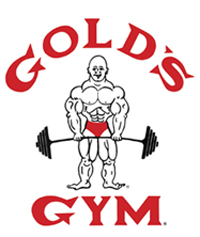 Drasin’s Gold’s Logo was an instant hit
Drasin’s Gold’s Logo was an instant hit
By 1975, Sprague had cemented Gold’s position as the place to train bodybuilders. It was a mecca for men of strength and a golden age for bodybuilding. Al Antuck’s musings in Iron Man magazine showed as much.
Why are some restaurants and other establishments the “in” places to go?…Whatever it is, Gold’s Gym on Pacific Avenue, one block from the beach in Venice, California has it. Gold’s attracts many of the top California physique stars — Schwarzenegger, Zane, Draper, Columbu, Bill Grant, Birdsong, to name a few….
Gold’s is a bodybuilders’ gym. Here you won’t find business men types who work out just to stay in shape. Most members are bodybuilders who work hard to gain bulk, density and symmetry, and they work hard with minimum time for kibitzing or goofing-off.
The idea that Gold’s was some form of bodybuilding mecca was born, but there was something the sport still lacked. Mainstream acceptance.
Pumping Iron and Going Hollywood
In 1974, freelance photographer George Butler and his partner, novelist Charles Gaines, called Sprague about the possibility of filming some of the bodybuilders in California. The two men had been responsible for Pumping Iron, a book on the subculture of bodybuilding published that same year, which met with financial success. The clear interest in bodybuilding from the general public encouraged the two men to take their work to the silver screen.
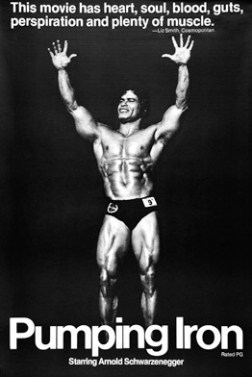
Despite the success of the book Pumping Iron, Gaines and Butler failed to secure any real form of funding for a movie. Studios were doubtful that a documentary on a niche subculture would garner any interest whatsoever. Not that the lack of support deterred the two men. Keeping costs to the bear minimum, Butler and Gaines managed to raise enough money for the necessary equipment and a contract for the star Arnold Schwarzenegger ($50,000 for the Austrian Oak’s services). Luckily for the aspiring film makers, they managed to secure a free venue for the majority of their filming, none other than Gold’s Gym. This is where we saw film legends like Arnold, Columbu, Waller, and countless others lift weights with unparalleled intensity.
The movie itself was shot over the course of a month and detailed the epic bodybuilding battle between Arnold and Lou Ferrigno for the 1975 Mr. Universe and Mr. Olympia titles. Aside from the constant financial worry the two men faced, they also had to deal with massaging the egos of the periphery lifters. While Arnold was earning $50,000, the rest were given paltry contracts, something that irked the men in Golds. Every now and then, scenes would have to be re-shot after a disgruntled bodybuilder deliberately stepped into the frame. Eventually, however, deals were struck, and by the end of 1975, Butler had all but wrapped up shooting the movie.
All he had to show for his work was a single print of the movie and no means of promoting it. For two years, the movie sat in the back offices of studios in what film buffs refer to as development hell. Frustrated that his movie would never see the light of day, Butler rented out space at the Whitney Museum in New York and had Arnold and Ken Waller pose on rotating discs to raise money. To increase interest in the event, Butler arranged for Candice Bergen to be a celebrity commentator and made noise about the fact that Arnold, then a Golden Glove winner for his performance in Stay Hunger, would be posing. The theme of the exhibition was living art, and surprisingly, the art critics loved it. Butler had only expected 500 people to show up. Instead, 5,000 attended, and he accumulated more money than he could fit in the registers. The publicity stunt worked and allowed Butler to finish production on his movie.
 Still from Pumping Iron
Still from Pumping Iron
In 1977, Pumping Iron finally hit US screens, and although fewer than one million Americans ended up seeing it that year, a buzz had been created. Soon after the movie’s release, we saw stars such as Clint Eastwood and Muhammad Ali begin to show up at Golds, looking to train at the Mecca of bodybuilding. Hollywood and popular culture became hooked on muscle.
The following years saw Arnold become a movie star with flicks such as Conan, Ferrigno became the Hulk, and mainstream actors like Stallone, Weathers, and Eastwood displayed chiseled physiques in their movies. Sprague’s Golds suddenly began to feature in fashion magazines and even a piece in 60 minutes. During this time, dues at Golds reached $200, a far cry from the $60 Joe Gold had charged in the beginning.
Gold’s in the 1980s
By the 1980s, bodybuilding and fitness in general had entered the mainstream; sadly, Sprague would not be part of it. In the late 1970s, following a personal tragedy, Sprague sold Golds on to Pete Grymkowski, Tim Kimber, and Ed Connors. The three men would help expand Golds’ influence across the US.
In 1980, Connors commissioned the first ever licensed Gold’s Gym in San Francisco and began spawning out licensees across the US. By 1981, there were over 5,000 Gold’s Gyms in the United States. Connors appears to have had a keen eye for the fitness industry, opening up the first group fitness class in Golds in 1981, about a decade before such movements became popular.
The 1980s were a period of sustained growth for the club, both domestically and abroad. In 1985, the gym went international, opening up its first branch in Canada to the joy of Canadian lifters everywhere. Unsurprisingly, the growing expansion of the gym franchise meant that the Gold brand began to pop up everywhere in American popular culture. The iconic Drasin-designed t-shirts were worn by Carl Weathers in an SNL skit and by numerous celebrity figures in other TV shows and films during this time.
The Nineties
By the time the 1980s rolled into the 90s, Golds membership established itself as a status symbol, with some scholars arguing that it became the McDonalds of the fitness community. From Janet Jackson to Michael Jordan, we saw the Golds brand pictured with a plethora of celebrities. By 1993, the gym franchises had over one million members, and Gold’s trainers were often presented as experts in the field, appearing in local and regional magazines with the latest fitness tips.
In 1996, chains were opened in Europe and Asia, including Moscow. Less than 5 years after the collapse of the Soviet Union, Gold’s Gym, an American institution, had found it’s way into the heart of Russia.
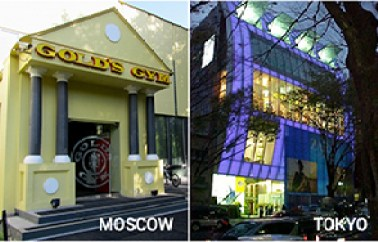 Gold’s Gym became a worldwide phenomenon.
Gold’s Gym became a worldwide phenomenon.
The continued success of the chain did have its downsides, however. Catering to larger and larger demographics meant that Golds was forced to move with the winds of the fitness industry. The relative re-birth of the cardio age saw Golds shift its focus more towards treadmills, steppers, and group classes. Free weights were still there, but now they took a secondary place to everything else the gym had to offer. During the 1990s, the franchise would be bought by Brockway Moran for an undisclosed fee. The private equity firm would spend five years acquiring other gyms and branching out the chain even further.
2000 to Present Day
In 2004, Gold’s was bought by TRT Holdings for over $150 million (3). TRT Holdings slowly but surely helped Gold’s evolve even further into a cross-sector company that happened to specialize in fitness.
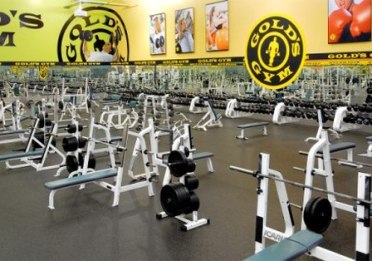
In 2004, the company created its own Gold’s Gym Fitness Institute to serve as a think tank on critical health and fitness issues. The same year also saw Gold’s branch out and become a national fitness sponsor of the American Diabetes Association’s Tour de Cure. In 2009, Gold’s released a cardio workout on the Nintendo Wii. All of which serves to demonstrate how Gold’s has moved away from being solely a gym into a multi-agency machine.
TRT never slowed down on Gold’s expansion either. At the time of writing, the gym franchise boasts 400 locations in 37 U.S. states and 20 other countries, with over three million members worldwide. It’s a far cry from the cold shack opened up by Joe Gold for his buddies in the ’60s.
References
(1) https://thebodybuildingarchive.com/the-story-of-golds-gym-the-mecca-of-bodybuilding/
(3) https://www.bizjournals.com/dallas/stories/2004/06/14/daily20.html
Dr. Conor Heffernan was an assistant professor of sport studies and physical culture at the University of Texas, Austin. Dr. Heffernan now resides in Belfast, providing sociology of sport lectures at Ulster University, which specializes in European and American health. Dr. Heffernan’s work examines the transitioning nature of diets in the twentieth century.


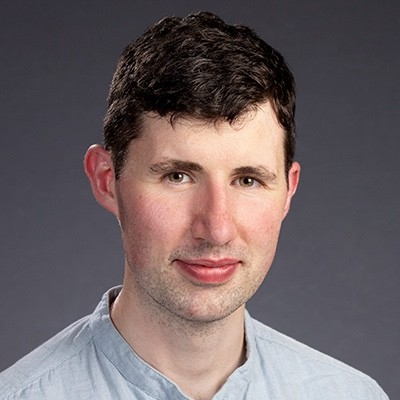

I am deaf and hearing impaired my name is Floyd leiby I would like to join body fitness in somewhere manatee county Florida
Thank
Floyd
Why Not mention Pete, Tim and Ed?
I visited Gold’s Gym in 1976 and really enjoyed the atmosphere especially it being a block from the beach.
To me, that’s a real bodybuilding gym.
Today, gyms have transformed into fitness centers which are unrecognizable with the amount of steppers and treadmills in gyms of today.